Chapter 19 – DDT: Miraculous Powder or Elixir of Death?

We have been talking a lot about how insects and insect-borne diseases have changed history. An obvious question is what sorts of efforts have been undertaken to control insects? The answer is that humans have been interested in controlling insects for millennia and usually by chemical means. As we will see in this chapter, the result of these efforts is itself a history-making and history-changing event. Nowhere is this made clearer than in the case of one insecticide: dichlorodiphenyltrichloroethane, or DDT. Although DDT is important in and of itself, it is truly revelatory in its power to teach us about the ways we must understand and respect nature in trying to achieve human ends. In this chapter, we will trace the evolution of DDT and the discovery of its insecticidal properties. Next, we will explore the impact of allied use of DDT on the course of WWII. Finally, we will analyze what happened when DDT was introduced for peacetime insect control as well as DDT’s subsequent fall from grace. Let’s take a look at this fascinating chemical.
Evolution of DDT
It seems appropriate to start this exploration with a quote from a very famous entomologist, Dr. Robert L. Metcalf. Dr. Metcalf was the first person in the U.S. to spray DDT for insect control in his job with the Tennessee Valley Authority. He was also among the first to call for suspending its use when news of the environmental side effects of DDT became known. Still, in a seminal paper by Dr. Metcalf entitled “A Century of DDT,” published in 1973, Dr. Metcalf reminds us that, despite DDT’s demise as an insecticide, it was a seminal force in our collective history. As he noted
“It is now almost exactly a hundred years since Othmar Zeidler synthesized the first molecules of DDT in the laboratory of Professor Adolf von Baeyer at the University of Strassberg . . . In the interim, this pleasant smelling, greasy white powder has had an influence on human ecology perhaps unmatched by any other chemical discovery including gunpowder, sulfanilamide, penicillin and plutonium.”
The context provided by Dr. Metcalf in A Century of DDT appropriately sets the stage for our discussion. Just as insects and insect-borne diseases have changed the course of history, so, too, has the development of the means to control them. As you will see, our ability to successfully secure the means of controlling insects is at once a cause for hope and, at the same time, a cautionary tale.
As Dr. Metcalf explained, the story began with a person named Othmar Zeidler. In 1873, Zeidler was an Austrian doctoral student who published a paper describing the synthesis of dichloro-diphenyl-trichloroethane, later to become known as DDT (Figure 19.1). Any interest generated from Zeidler’s new synthetic scheme was purely academic. The main practical application was to be found in the dyestuff industry, which at the time was an interest of the J.R. Geigy company with which Zeidler’s adviser, Adolf von Baeyer, was working. Prior to this time, dyes were gleaned primarily from plant extracts. However, Zeidler’s synthesis allowed molecules like DDT to be produced in a single step. This, of course, lowered cost of production and was important to the textile industry which was just learning how dye interacted with fabric to create color.
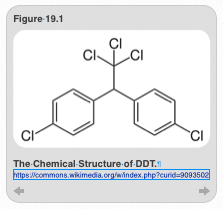
Zeidler reaped little benefit from his discovery. In fact, he ended his career as an apothecary in Vienna. However, his adviser, von Baeyer, was awarded the Nobel Prize in Chemistry, in part, as a result of Zeidler’s work and other studies on the synthesis of diphenyl molecules. Ever the historian, Robert Metcalf was at his most poetic when imagining the world if the insecticidal properties of DDT had come to light a little earlier: “One wonders how the stream of history through the Franco-Prussian War, World War I and the collapse of the Balkans and of Czarist Russia and that of Mainland China might have been altered if a stray insect crawled upon Zeidler’s pile of shining crystals and the chemist had gained an inkling of the enormous powers of the insecticide in controlling typhus, malaria, plague, and other vector-borne diseases of man. . . However, it was not to be and the compound slumbered on the shelf for another 65 years.”
In 1935, Dr. Paul Muller, a Swiss Chemist working for the J.R. Geigy company, began a systematic search for new insecticides. The currently available insecticides, e.g., arsenates, rotenoids, and pyrethroids, were failing to mitigate the major insect pests. New compounds were desperately needed. Muller experimentally tested prospective replacements by spaying the materials into large glass chambers of houseflies or other insects. By 1939, Muller’s search had narrowed to chemicals having a biphenyl structure—the skeleton upon which DDT was built. As Muller worked for Geigy, the same firm that Adolf von Baeyer had been affiliated with, it was a matter of time before Muller would unearth Zeidler’s paper and use his synthetic scheme to resurrect DDT. It was then that DDT’s capacity to kill insects came to light.
After the initial test of DDT, a very surprised Muller reported: “My fly cage was so toxic after a period, that even after a very thorough cleaning of the cage, untreated flies touching the walls fell to the floor. I could carry on my trials only after dismantling the cage, having it thoroughly cleaned and after that, leaving it about a month in the open air.” The insecticide DDT had been discovered. It worked out well for Muller who received a Nobel Prize in 1948 for discovering the insecticidal properties of DDT.
DDT in World War II
The timing of Muller’s discovery was propitious as WWII was underway. The specters of typhus, spread by lice; mosquito-borne diseases such as malaria and filariasis; and dysentery, spread by flies were once again ravaging the troops. As the theatres of conflict spread into the South Pacific and North Africa, insect problems intensified.
During much of WWII, information about the insecticidal activity of DDT was kept secret by military regulation. By 1940, the Geigy Company obtained a patent for DDT and reported DDT’s effectiveness in controlling lice to the U.S. Military Attache in Berne. This was later verified by the United States Department of Agriculture, prompting the US to begin making DDT at the Cincinnati Chemical works in 1943. The Swiss were also busy exploring insecticidal uses of DDT and officially introduced DDT as an insecticide for the war effort. It is said that in previous wars, insect-borne diseases scored more casualties than did the combined efforts of all implements of war. But WWII was to be different. Girded by field tests of DDT carried out under the auspices of the Swiss Red Cross, DDT became the official insect control agent of allied forces.
But the claims made about DDT were so remarkable that skepticism reigned in many quarters. The famous British entomologist, Vincent Wigglesworth, was among the skeptics. However, he agreed to test the chemical and rapidly became a supporter. Said Wigglesworth: “New ways of using DDT were discovered, as it seemed, almost daily—until both British and American entomologists almost came to feel that they had discovered the stuff.” Even Winston Churchill weighed in, hailing DDT as the “miraculous powder.” One might say it was DDT’s finest hour.
The testing and use of DDT, like the war, intensified. Production of DDT in the US was given AA1 priority—the same given to penicillin by the US War Board. Most of the DDT produced went immediately overseas.
By 1944, the Director of the US Office of Scientific Research and Development recommended the formation of a national DDT Committee under the supervision of the Surgeon General to oversee the research and production of DDT. Technical problems were overcome and production expanded from 1,000 pounds/month in 1943 to 550,000 pounds/month in 1944 to 3,000,000 pounds/month in 1945.
Back at the front, DDT was at war with insects. A remarkable event occurred in 1943 when Naples was captured by the Allies and suffered a serious epidemic of typhus. The Rockefeller Foundation was called in to delouse the population. Forty treatment stations were set up across the city, each one treating tens of thousands of people per day with DDT. Treatment involved applying DDT directly on the human body using compressed air guns (Figure 19.2; image taken at the U.S.-Mexico border after the war, but the concept is the same). All told, 1.3 million people were treated and the typhus epidemic vanished within a month.

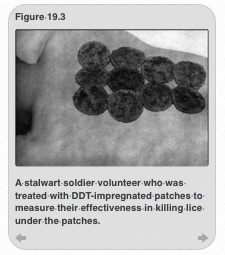
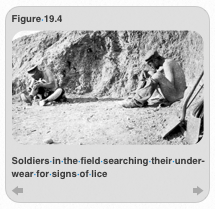
Soldiers also volunteered to help test DDT in a field setting. Figure 19.3 shows a soldier volunteer with patches covering lice on his back. The patches were treated with DDT. After a period of time, the patches were removed to measure its effectiveness of DDT in killing the lice. Figure 19.4 shows soldiers searching their own underwear for signs of lice for which they would then seek treatment with DDT.
DDT was used liberally in the lives of allied soldiers. Soldiers and sailors by the millions were equipped with small cans of DDT to rid their bodies of insect vermin. In extreme cases, their bodies could be inundated with DDT using compressed air guns. In barracks, DDT could be applied directly to walls to kill insects, and bushes and outdoor venues could be treated with DDT by airplane, fogging, or ground spraying.
DDT was valuable because it was so effective. Its effectiveness, in turn, was due to several properties. First, it was very cheap to produce, costing about 18 cents per pound during the WWII years. Second, as already indicated, it was believed that DDT was so safe that it could be directly applied to the human body and has no acute toxicity to mammals including humans. Third, DDT was broad-spectrum meaning that it was generally effective against all insects and other arthropods. In times of war, it is much more efficient to have a single, cheap insecticide that will work in all environments against all insects. DDT seemed to fit that bill perfectly. Finally, DDT was persistent. As noted by Muller in his early tests, DDT would last for months even in strong sunlight that would normally break chemical bonds. DDT resisted degradation and could therefore be applied once, and be expected to remain active for many weeks. In times of war, it is a great asset to not have to reapply an insecticide under combat conditions.
We cannot know specifically how much DDT did to strengthen allied troops and assist in winning the war. But it is certainly the case that DDT greatly lessened the ability of insect-borne disease to ravage the troops. It was, without question, one of the important factors leading to an allied victory.
DDT and Peacetime Use
When WWII war was over, respect for DDT was so great that former soldiers began to use it around the house and farm. In the post war years, 80% of domestic DDT production was used in agriculture in the United States. By 1961, DDT was registered for use on 334 different crops. Large increases in crop yields (or reduction in damage) were observed as a result of the agricultural use of DDT. Even recalcitrant pests like gypsy moth and spruce budworm were apparently under control with DDT. And because of belief in DDT’s inherent safety, it could be sprayed in a crowded airplane cabin (Figure 19.5); dusted over livestock intended for human consumption (Figure 19.6); or sprayed on a public beach with children playing in the spray boom (Figure 19.7).
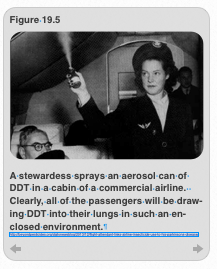
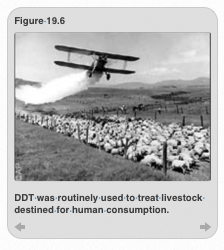
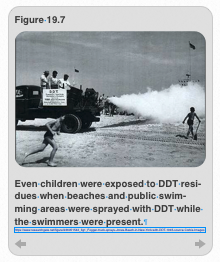
The remaining 20% of DDT produced domestically was used in human health campaigns. The World Health Organization (WHO) proclaimed that world–wide eradication of malaria was imminent in 1955 as a result of using DDT. By 1972, malaria had been eradicated in 37 countries and was under control in 80 others. This had a salutary effect on human life expectancy in malaria-ridden areas. Using India as an example, in the years 1933–35 (before DDT use), 100,000,000 new cases of malaria were reported, and during this time, the average life expectancy of an Indian was 32 years. Following the introduction of DDT, the number of new malaria cases dropped to 50,000 per year and the life expectancy of the average Indian catapulted to 52 years. This was an incredible achievement.
The world and entomologists forecasted an end to the conflict with insects—all to be achieved by the chemical eradication of insect pests with DDT. Fantastic claims were made in prominent publications such as Time Magazine, which published an article that proclaimed “No Flies in Iowa” (April 14, 1947 issue). Similarly, the Reader’s Digest was pleased to report that an entire town had abolished house flies in 1948.
Even more surprising, professional entomologists suggested that we ought to collect houseflies and cockroaches so that they could be preserved as museum specimens since they were likely to be driven to extinction by using DDT and other insecticides. Even some very well-known figures succumbed to adoration of DDT. Figure 19.8 shows an early effort of the advertising guru whose work would later morph into the Cat in the Hat and the Grinch Who Stole Christmas. Yes, Dr. Suess (Theodor Seuss Geisel) wrote copy to peddle DDT.
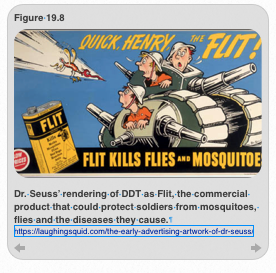
Given the immense, unbreakable faith that DDT was the panacea for all of our insect problems, we are entitled to ask, why didn’t DDT eradicate malaria? Indeed, why did malaria come back with a vengeance? Why are there still houseflies in Iowa? And, even more remarkably, why was DDT banned by the USEPA in 1972?
DDT’s Fall From Grace
The answer again lies with DDT’s properties. The very properties that made DDT an incredibly valuable wartime insecticide also made it an excellent environmental pollutant. Similarly, DDT’s biological properties, other than its capacity to kill insects, were largely unexplored until the 1960s. Once attention was turned to the range of toxic activity of DDT, it became apparent that DDT was not innocuous to humans and other organisms.
The fact that DDT was broad-spectrum meant that it would kill lots of things including species that we specifically did not want to kill. Moreover, the fact that it was persistent was an asset in wartime but much less so during times of peace. In most noncombat situations, it is not ideal to have insecticidal residues that will persist for months or, in some cases, years. Finally, DDT is very hydrophobic (water fearing). This means that DDT is highly insoluble in water but is extremely soluble in fatty tissues. Thus, DDT will be rapidly absorbed into living tissues, and because it is persistent, it will accumulate there. Two critical events occurred in 1962 that brought these matters to light and, in the process, sealed DDT’s doom.
The sixties were a tumultuous decade. But even with that proviso, 1962 stands out as a pivotal year. In science, two monumentally important things took place: first, a new technology became widely available in the form of Gas Liquid Chromatography or GLC. This allowed scientists to isolate chemicals from diverse media such as soil, water, and air, separate the chemicals form the media, determine the identities of the chemicals, and quantify the residues. Second, a book entitled Silent Spring was published. In it, author Rachel Carson reviewed scientific literature on DDT and reached the conclusion that DDT and other insecticides were having a variety of negative effects on wildlife and humans because of their lack of selectivity and their persistence.
With the advent of GLC, we now had a powerful tool that would allow us to screen for the presence of contaminants in any environmental sample in MINUTE amounts. We could quantity residues at PPM (part per million) or PPB (part per billion) levels. A ppm is equivalent to a single drop of water in a volume the size of a train car. A part per billion is roughly equivalent to a drop of water in a total volume of an Olympic-sized swimming pool. What we learned from this technology is that DDT didn’t just do its job and go away. Rather, DDT had circulated around the globe following prevailing weather patterns and was showing up even in very remote places such as the polar ice caps where it clearly had never been used to control insects. The latter was an important discovery made by Ohio State University’s own Tony Peterle in 1969. DDT was, and still is today, found in the bodies of most Americans even though it hasn’t been used for decades except for emergency circumstances.
Although average people wouldn’t be familiar with the results of GLC studies, Rachel Carson’s book became a best seller and the message that insecticides had side effects that were quite risky resonated with the American people. Carson presented data on human body residues of DDT that demonstrated a link between life habits and DDT residues in the human body. People working in pesticide formulating plants, for instance, had the highest levels of DDT in their tissues, followed by agricultural workers. This may not sound too surprising. But the public was genuinely shocked to learn that all of us have DDT in our tissues.
The pesticide industry reacted quite negatively to the publication of Silent Spring and inaugurated a campaign to minimize the impact of the book by making its author appear to lack credentials. Ms. Carson was an employee of the U.S. Forest Service and, although she had a master’s degree, she lacked a Ph.D. This was made out to be a serious deficiency by Silent Spring’s detractors. The fact that she was a talented naturalist who had written other well-received books was of no consequence to her critics. The fact the Ms. Carson was a woman also came up for discussion in ways that were meant to make her look unprofessional. She withstood the personal attacks with magnanimity and, in the end, her work was praised by the bulk of the scientific world that was not on the payroll of the pesticide companies. In 2006, the editors of Discovery Magazine designated Silent Spring as one of the 25 most important scientific books ever written.
An intense research effort to understand the effects of DDT on both wildlife and humans commenced. It was suspected that DDT was having a profound impact on raptorial birds such as the national symbol, the bald eagle. Subsequent research determined that DDT inhibits the enzyme that allows mother birds to incorporate calcium into the structure of their eggshells. Without calcium, the eggshells become brittle and would break under the weight of the mother bird. Raptorial birds of many types began to decline in number, and some were imperiled to the extent that they were becoming endangered.
We also learned that when DDT eventually did breakdown, an event that could take years depending on where the DDT was found and the degradative forces to which it was subjected, the breakdown products might also be dangerous. One of the first breakdown products of DDT is generated by stripping off a single hydrogen and a single chlorine atom, which converts DDT to a molecule called DDE.
DDE is not insecticidal and will not kill insects. However, DDE shares many of DDT’s chemical properties and shows similar environmental behavior. DDE is even more fat soluble than DDT, for instance, and will accumulate in fatty tissues even more readily than DDT. Unfortunately DDE shares some of DDT’s abilities to interfere with biochemical systems such as calcium deposition in raptor eggs and some pseudohormonal activities as well. Finally, because DDE is even more fat soluble and less biodegradable than DDT, DDE is likely to accumulate in food chains at even high levels than DDT.

The ability of DDT and its derivatives to bioaccumulate, or accumulate in living systems, beyond its concentration in environmental media such as water and soil, is the source of many problems. Table 19.1 gives data from a classic paper by Harrison et al. published in Science Magazine in 1970. The authors examined DDT concentrations in different trophic levels of a Lake Michigan food chain. As you can see, the concentration of DDT in water is very low—only a part per billion. However, because bottom mud has a significant lipophilic organic component in it, DDT accumulates at levels in bottom mud that are 3 orders of magnitude higher. And because the levels of fatty tissue generally increase with each trophic link in the food chain and organisms at top trophic levels tend to live longer, there is roughly a ten-fold increase in DDT concentrations as one ascends trophic levels in the food chain. The levels found in raptorial birds are so high that they would be expected to cause eggshell thinning and neurological deficits as well. Papers such as these began to turn both scientific and public opinion against DDT.
New studies on DDT forced proponents and critics alike to confront another issue with DDT. Although DDT is not acutely toxic to humans—at least at typical application rates, DDT does have significant biological effects on vertebrates when exposure takes place for long periods of time at low levels. In other words, lengthy exposure to DDT at levels that would cause no visible toxicity in the short term can result in accumulation of DDT in nervous system and endocrine tissues at high enough levels to cause significant effects. This is the result of bioaccumulation (concentration in living organisms due to DDT’s preference for fatty tissues) and biomagnification (accumulation through the food chain). Two studies were particularly influential in further changing attitudes about DDT.
The first of these was the Report of the Secretary’s Commission on Pesticides and their Relationship to Environmental Health on Relationship to the Environment. The Commission reviewed all ecological and medical effects of DDT and concluded that the U.S. should eliminate all uses of DDT within two years. An exemption was granted for public health use of DDT. This recommendation was unanimously supported by the U.S. Departments of Health; Education and Welfare (now the Department of Health and Human Services); and Agriculture and Interior. We can’t think of another recommendation that these three agencies have agreed on since. And since they were recommending elimination of a chemical that had iconic status, it is all the more remarkable.
The second study was the 1969 report of the National Cancer Institute (NCI), which provided data indicating that DDT was carcinogenic to rats. To be fair, there were many complaints that the doses used in the study were too high or that the strain of rats used had a predilection for cancer that exaggerated the dangers. Even so, this study simply added to a growing body of evidence that chronic exposure to DDT could have devastating effects on vertebrates. As a consequence of studies like the NCI study and the Mrak Report (1969), the U.S. EPA made the decision to ban DDT in the U.S. in 1972 with the exceptions already mentioned.
The reverence in which DDT was held for so long followed by the fairly abrupt decision to cancel its registration as a pesticide forced us to examine the societal forces that buffeted DDT. The United States is a relatively wealthy country. Compared to other nations, we have the capacity to pay for a clean environment and avoid using products that have harmful effects. It is sometimes inconvenient. It may be more costly, but we have the luxury of avoiding the use of hazardous chemicals. We can decide that bald eagles are so important a symbol of American exceptionalism that we can forego using products such as DDT so that our national symbol is spared. We can also afford to worry about getting cancer because most of us will live long enough that it could become a problem.
But in the rest of the world, in developing nations for instance, most people are just concerned about where the next meal is coming from. Accordingly, they balance the risk equation differently. DDT might accumulate in the food chain. It may even cause biological effects somewhere down the line. But if your main concern is feeding your children today and DDT is the chemical that can kill enough insects to ensure a good crop, the use of DDT may seem like a panacea. Of course, we now know that if DDT had been used continuously, it would eventually stop working due to the evolution of resistance among insects to DDT. Indeed, insects have the biological capacity to carry out the detoxification of DDT to DDE with one enzyme. This eliminates the insecticidal activity of DDT, and insects that have this enzyme will not be killed by DDT. Still, despite the reality of the environmental problems caused by DDT, the demonstrated chronic effects, and the evolution of resistance by insects to DDT, the calls for using DDT in public health campaigns and even agricultural crops are made regularly. Since resistance is just an enzyme away, this is really not a good idea except in certain very focused and limited situations.
In this sense, DDT represents a conundrum. Over a century has elapsed since the year of DDT’s discovery, and we still don’t fully understand the risks of using DDT. It’s been over 50 years since the first ecological warnings against indiscriminate use of DDT were levied and we still don’t fully understand its ecological behavior. And, more than 40 years have elapsed since DDT was implicated in producing cancer and we are still not sure if it is an actual cancer risk for humans.
What we do know is that pesticides are specifically designed and released with the intention of killing living things. The word insecticide implies that the target is an insect but we know that most insecticides will kill or harm other organisms as well. As a result, the use of insecticides results in some level of risk. When the human need is great and alternatives are few, a substantial risk might be tolerable. However, when the dangers for which DDT might be used have abated, such as in the U.S., the risk posed by DDT is less acceptable. DDT usage is a question of balance in which social, scientific, ecological, economic, and political factors collide.
To the extent that events that have happened in the past can teach us about the future, DDT is an excellent paradigm. DDT, in essence, set the standard for modern insecticides. It helped us identify what the desirable properties of an insecticide are. Certainly, a high level of effectiveness against target pests tops the list of positive attributes. But DDT also taught us what properties we should avoid in an insecticide. Extreme persistence is no longer viewed as an asset, nor is being highly broad-spectrum considered a trait that is always an asset.
Likewise, today we are unlikely to endorse using products that can accumulate in living tissues. We must also evaluate the context in which these chemicals will be used. Will they be applied inside a human structure where they can be contained, or in the environment where they can spread? What are the consequences of not using an insecticide? Are there substitute chemicals or cultural methods that might reduce the risk? All of these questions must be evaluated and the information obtained must be used to design a sustainable control program. It is no longer acceptable to spray a crop every Monday because that makes it easier for the grower. These days, we will want to know something about the pest population and whether its levels justify using an insecticidal spray. The debate continues. No doubt, 20 or 30 years from now we will marvel at how primitive our current approach to controlling insects seems. At the same time, we realize that the knowledge we gain today will become the foundation for improvements of the future. For that reason, it is vitally important that this research continues.
References
Chapter 19 Cover Photo: DDT Sign. Source: Archives of the USDA APHIS Pest Survey Detection and Exclusion Laboratory. Accessed via https://www.fs.fed.us
Figure 19.1: Chemical structure of DDT. CC0 Public Domain: Leyo. Accessed via https://commons.wikimedia.org/w/index.php?curid=9093502
Figure 19.2: DDT being applied directly to the body. Photo by the Smithsonian Institution taken in 1956 at the U.S.-Mexico border. Accessed via http://www.latimes.com/nation/la-na-zika-spraying-20160805-snap-htmlstory.html
Figure 19.3: DDT louse patches. Image: author unknown. Cannot locate image source.
Figure 19.4: Soldiers checking their clothes for lice. Image: author unknown. Cannot locate image source.
Figure 19.5: DDT spraying inside an airplane cabin. Image: author unknown. Accessed via http://beyondpesticides.org/dailynewsblog/2013/12/flight-attendant-links-airline-insecticide-use-to-his-parkinsons-disease/
Figure 19.6: Airplane dusting livestock with DDT. Image: author unknown. Accessed via http://www.pophistorydig.com/topics/tag/ddt-1950s/
Figure 19.7: Children spraying with DDT on beach. Image: Corbis Images. Accessed via https://www.researchgate.net/figure/236051542_fig1_Fogger-truck-sprays-Jones-Beach-in-New-York-with-DDT-1945-source-Corbis-Images
Figure 19.8: Dr. Seuss’s Flit ad. Image: Flit, 1940. Accessed via https://laughingsquid.com/the-early-advertising-artwork-of-dr-seuss/
Table 19.1: DDT in Lake Michigan food chain. Data from Harrison et al. 1970. Available at http://yannalaw.com/wp-content/uploads/Science_Systems-Studies-DDT-Transport1.pdf
Additional Readings
Carson, R. ( 1962). Silent Spring. Houghton-Mifflin, New York, 378 pp.
Harrison, H. L., et al. (1970). Systems studies of DDT transport. Science 170.3957: 503-508.
Metcalf, R.L. (1973). A Century of DDT. J. Ag. Food Chem. 21: 511-519.
Mrak, E. (1969). Report of the Secretary’s Commission on Pesticides and their Relationship to Environmental Health. Parts I and II.
National Cancer Institute
Peterle, T.J. (1969). DDT in Arctic Snow. Nature 224: 620, doi:10.1038/224620a0.
Tarjan R, Kemeny T. Multigeneration studies on DDT in mice. Food Cosmet and Toxicol. 1969; 7:14–222.